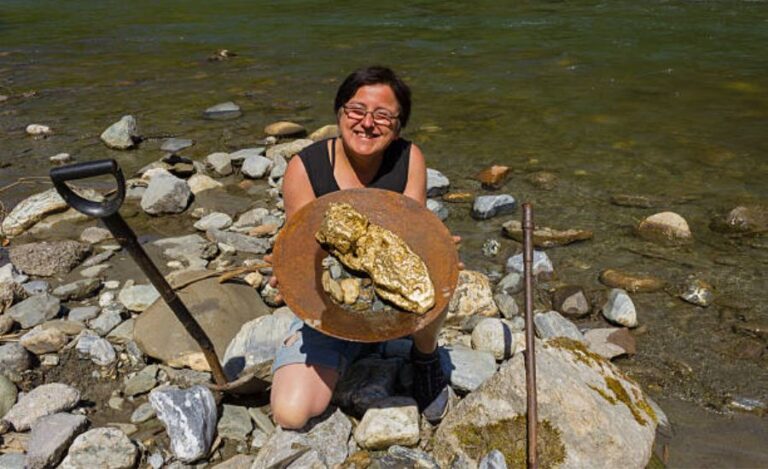St Lazarus Abba Kwi cuban History, Origin, Role & More
Introduction
In Cuba’s spiritual landscape, St Lazarus Abba Kwi Cuban is a significant figure who represents a diverse range of religious beliefs, cultural practices, and community customs. He is more than just a worshipped figure; he is ingrained in the lives of numerous people all across the island as a symbol of hope, healing, and resiliency. His influence is felt by people who are looking for solace and courage in the face of adversity, even outside of religious rituals.
St. Lazarus is often seen with a dog by his side, signifying friendship and loyalty. This represents constant support throughout trying times. This visual highlights a nurturing and caring mentality that is fundamental to Cuban culture, reflecting the close relationship that many people in the country have with their faith. Beloved as a defender of the sick and downtrodden, St. Lazarus is revered for his extraordinary healing abilities.
The St. Lazarus celebrations are colorful manifestations of Cuban spirituality and identity. At his shrine in El Rincón, a location that represents healing and optimism, thousands of people assemble annually. Through customs, songs, and sincere prayers, these events highlight the community’s resilience and togetherness. Offerings from participants frequently highlight their individual experiences as well as the significant impact St. Lazarus has had on their lives.
St. Lazarus is unique because he can transcend conventional worship and represents the tenacity of the Cuban people. He reminds many that there is always hope for recovery and atonement, even in the face of hardship. The intense devotion to St. Lazarus demonstrates how faith can be a potent source of support, offering comfort in trying times.
Examining the lengthy life of St. Lazarus shows a biography that is entwined with the larger cultural backdrop of Cuba. His legacy encourages future generations to look to him for strength and consolation, serving as a tribute to the enduring power of faith and tradition. Knowing the significance of St. Lazarus in Cuban culture highlights the universal search for healing and hope that cuts across boundaries and religious beliefs, which enhances your awareness of the culture.
The History and Origin of the Saint
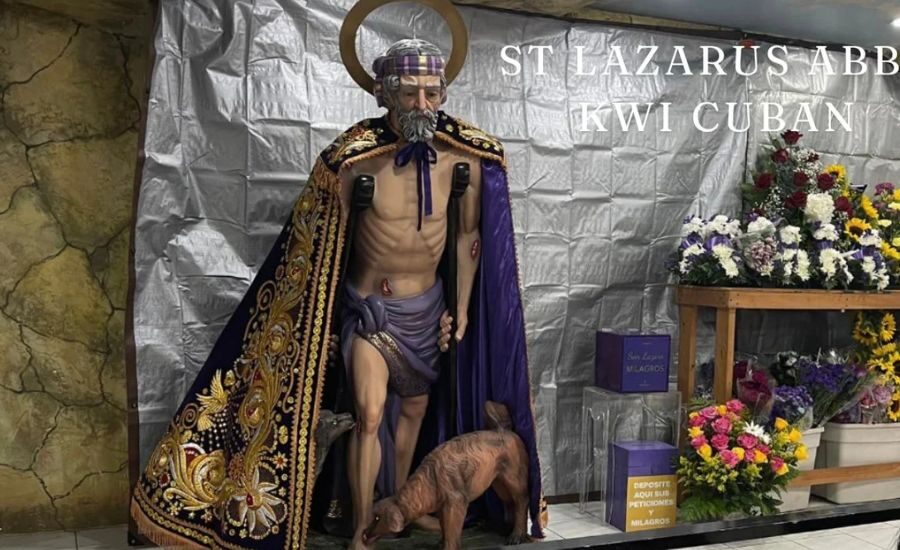
In Cuban tradition, St. Lazarus is known as Abba Kwi, and his origins can be traced back to biblical times. He is frequently associated with the account of Lazarus of Bethany, the renowned revived by Jesus. He has become a powerful symbol of healing and hope in the hearts of many people because of this amazing miracle.
When African slaves brought their spiritual beliefs to Cuba and mixed them with Catholicism, the story of St. Lazarus took on new depth. As a result of this blending, a distinct cultural tradition emerged in which St. Lazarus came to represent a shield for those looking for solace from their suffering.
The devotion to St. Lazarus grew in the late 19th century among Cubans who were enduring societal injustices and health issues. He became known for his tenacity and faith throughout this time, which encouraged and consoled many people who were looking for miracles in difficult circumstances.
This fascinating historical voyage demonstrates how religious customs change and adapt to fit local settings while holding great significance for future generations. St. Lazarus is still seen as a representation of strength and hope, demonstrating the ability of the human spirit to persevere in the face of adversity.
What is the Significance of St lazarus abba qui cuban
The association of St. Lazarus, also known as Abba Kwi in Cuban tradition, with dogs is a potent and symbolic feature of his image. St. Lazarus is usually shown with two devoted dogs in Afro-Cuban religious rituals, where he is frequently identified with Babalu Aye. This very symbolic imagery represents empathy, loyalty, and the dignity that comes with bearing hardship.
Dogs are more than just decorative elements in these paintings; they have deeper metaphorical meanings. These animals are regarded as faithful friends who stick by you through good times and bad. This representation implies that all people are deserving of respect and compassion, regardless of their circumstances or social status. This is particularly true in Cuban society, where dogs are revered as guardian and devoted symbols.
Furthermore, the relationship between St. Lazarus and his dogs conveys a more general message about society: that the sick, the poor, and the disadvantaged are valuable people who should be treated with compassion and respect. This symbolism clarifies the significance of St. Lazarus’s worship in Cuban culture and emphasizes his dual position as a healer and a protector of the oppressed. Using this iconography, St. Lazarus comes to life as a ray of humanity and hope, promoting the worth and treatment of every person and serving as a reminder of our collective duty to help those in need.
The Role of St. Lazarus in Cuban Culture
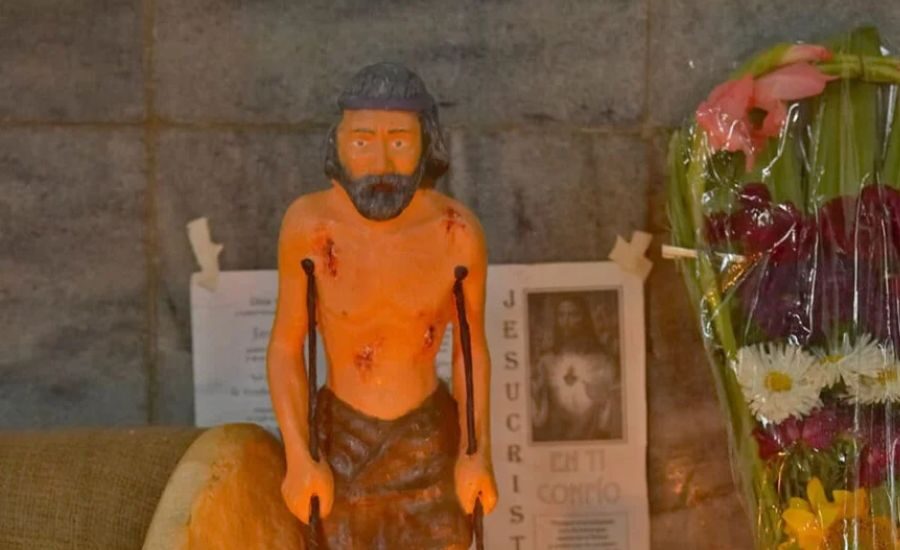
St. Lazarus, often referred to as Abba Kwi in Cuban culture, is revered in Catholicism and Afro-Cuban mysticism. He is a symbol of protection and healing, giving people who are struggling a reason to hope. Many people believe in his purportedly supernatural abilities and turn to him for intercession when they are unwell.
In both public and residential spaces in Cuba, sculptures and altars honoring him are frequently adorned with vivid flowers. The celebrations of St. Lazarus’s life elegantly combine Catholic ceremonies with African traditions, showcasing the island’s diverse cultural heritage. His impact unites communities, particularly on December 17, his feast day, when there is a significant pilgrimage to El Rincón. This event highlights St. Lazarus’s lasting influence on Cuban society and his function as a unifying symbol for those in need of courage and consolation.
The Fusion of Catholicism and Santería in Cuban Culture
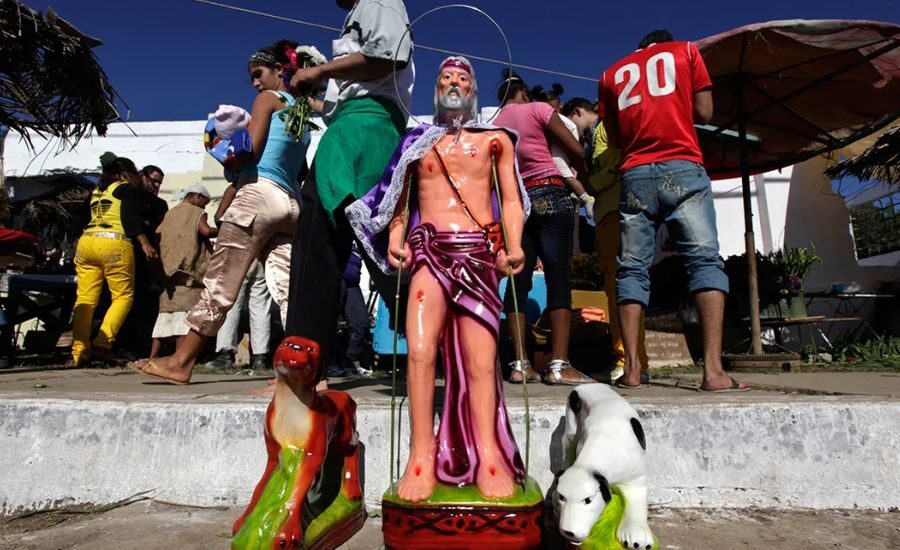
In Cuban culture, the worship of St. Lazarus, also known as Abba Kwi, is a remarkable illustration of religious syncretism—the blending of many spiritual traditions to produce a unique and unified practice. The way that Santería worship of Babalu Aye and Catholic devotion to St. Lazarus are intertwined is one example of this synthesis. This blending of customs enhances many Cubans’ spiritual journeys and demonstrates the flexibility and tenacity of religious practices.
The Santería picture of Babalu Aye contrasts significantly with the Catholic image of St. Lazarus, who is portrayed as an aged and weak figure in this syncretic religious system. As a reflection of his biblical story of suffering and miraculous cure, St. Lazarus is frequently shown in Catholic art in a vulnerable state. On the other hand, Babalu Aye, often seen using crutches, is shown on Santería altars, wearing plain burlap attire and sporting sores. This depiction highlights his function as a protector and healer deity, demonstrating his close bond with people facing hardship and disease. The veneration for St. Lazarus draws attention to the Cuban people’s profound spiritual needs and their persistent search for healing and hope through these two depictions of the saint.In Cuban culture, the worship of St. Lazarus, also known as Abba Kwi, is a remarkable illustration of religious syncretism—the blending of many spiritual traditions to produce a unique and unified practice. The way that Santería worship of Babalu Aye and Catholic devotion to St. Lazarus are intertwined is one example of this synthesis. This blending of customs enhances many Cubans’ spiritual journeys and demonstrates the flexibility and tenacity of religious practices.
The Santería picture of Babalu Aye contrasts significantly with the Catholic image of St. Lazarus, who is portrayed as an aged and weak figure in this syncretic religious system. As a reflection of his biblical story of suffering and miraculous cure, St. Lazarus is frequently shown in Catholic art in a vulnerable state. On the other hand, Babalu Aye, often seen using crutches, is shown on Santería altars, wearing plain burlap attire and sporting sores. This depiction highlights his function as a protector and healer deity, demonstrating his close bond with people facing hardship and disease. The veneration for St. Lazarus draws attention to the Cuban people’s profound spiritual needs and their persistent search for healing and hope through these two depictions of the saint.
Abba Kwi’s contributions to the community of St. Lazarus
Abba Kwi is greatly appreciated by the St. Lazarus community in Cuba, as he provides them with direction and hope for their future. His influence on the area is profound, changing many people’s lives in a substantial way.
One of his most significant accomplishments has been the creation of educational initiatives aimed at equipping people and children with necessary skills so they may find better jobs. Furthermore, he has led health campaigns to promote preventative care and increase public awareness of common health problems.
Local artists may count on Abba Kwi’s backing to help them access markets outside of their own area. By means of these cooperative projects, his impact keeps strengthening the basis of the community, enhancing people’s lives and building resilience in the area.
Celebrations and Traditions Associated with St. Lazarus

In Cuban culture, celebrations honoring St. Lazarus, often referred to as Abba Kwi, are vibrant and rich in history. Devotees congregate at the well-known El Rincón Sanctuary on December 17th of every year, changing the area with bright displays and colorful offerings.
White is a common color worn by participants, signifying purity and reverence for the saint. Many come bearing fresh flowers and candles in remembrance of his legendary healing powers.
While rituals differ from culture to culture, they typically involve passionate prayers, dancing, and music. The sound of drumming fills the air, inspiring worshipers to move in tandem with each other.
Adding pets to the festivities is a unique feature, as participants ask for blessings for their well-being and security. This custom emphasizes St. Lazarus’s close relationship with animals and the compassion they stand for.
A defining feature of the celebrations are the street processions, which help people come together as they relate their individual accounts of his healing miracles. The mood is one of thankfulness and gladness, a reflection of the generations’ everlasting dedication to this beloved character.
The positive impact on the local economy and infrastructure
The economic landscape of St. Lazarus has significantly changed as a result of Abba Kwi’s activities, creating new job possibilities and improving the general standard of living for locals. Important infrastructural upgrades have been essential to this change, since they have promoted both economic growth and a better feeling of community.
His community engagement initiatives have rejuvenated regional marketplaces, spurring the expansion of small enterprises and inspiring an entrepreneurial mindset among locals. The citizens’ deep sense of connectedness to their environment has empowered them and fueled continuous development and advancement.
The beneficial impact that Abba Kwi’s efforts will have on the people of St. Lazarus will linger for many years after his departure
Personal stories and testimonies from those affected by Abba Kwi’s work

The neighborhood seamstress, Maria, describes how the Abba Kwi group changed her life. She remembers, “I was concerned how I would manage to pay my bills,” her voice beaming with appreciation for the help she got.
And then there is Carlos, a retired teacher who actively takes part in Abba Kwi’s community workshops, which are centered around helping impoverished children in India. Visibly impacted by the event, Carlos says, “He taught us that information is vital, but knowing how to apply it is much more crucial.” Numerous attendees have been motivated to take action and change the world by the seminars.
Even the youngest people in the neighborhood are affected. When Little And talks about the recently built play areas made possible by Abba Kwi initiatives, she sparkles with excitement. “We can play now without worrying about safety,” she joyfully declares, her eyes beaming.
These tales all demonstrate the significant transformations that Abba Kwi’s mission brought about, turning adversity into opportunity and building the St. Lazarus community’s resilience. Collectively, they show how optimism can thrive and enable locals to forge ahead and become stronger.
Challenges faced by Abba Kwi and how he overcame them
Limited financing was one of the biggest obstacles Abba Kwi faced in his efforts to improve the St. Lazarus community. He faced several difficulties. He realized that using conventional tactics would not be adequate and that in order to have a significant influence, he would need to take a different tack.
The community’s distrust was another barrier. Many locals were wary of new initiatives because they feared that they would upset their well-established way of life. Nevertheless, Abba Kwi persevered patiently, holding candid conversations and offering careful justifications in order to gain their respect and cooperation.
His efforts were further confounded by logistical issues, especially when it came to organizing events and moving merchandise. In order to address these problems, he developed close bonds with nearby company owners, encouraging cooperation that enhanced resource sharing and expedited processes. Abba Kwi overcame these obstacles and fought to create a more cohesive, stronger community by being tenacious and creative.
.Miracles and Healing Powers of St. Lazarus
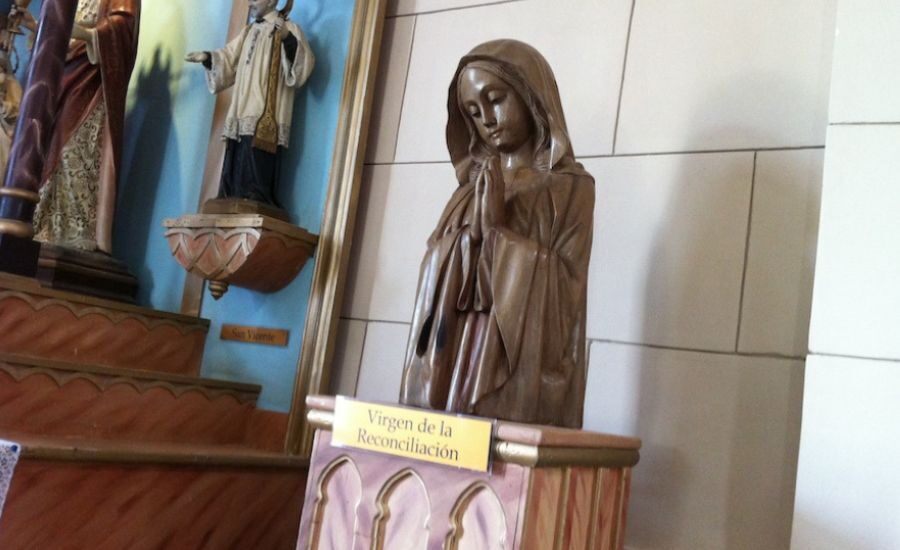
Saint Lazarus Abba Kwi is highly revered for the miracles he is said to have performed and his extraordinary healing abilities. Numerous followers go to him in times of great need in order to get healing from sicknesses that appear insurmountable.
Inspiring tales abound in the community, telling of those who, after making heartfelt prayers or sacrifices at his shrines, were able to find healing from long-term ailments. His healing influence extends beyond physical illnesses; many find mental solace and fortitude in their steadfast trust in him.
Often seen with a dog, St. Lazarus is a symbol of friendship and loyalty as well as the strength that comes from faith in the face of adversity. Those who are praying for direction and healing find great resonance in this visual.
Moreover, moving testimonials from neighbors frequently describe healings that defy scientific explanation. In addition to reinforcing the notion of St. Lazarus’s heavenly abilities, these gripping tales inspire numerous devotees to participate in rituals and devotions meant to promote health and wellbeing in their lives.
Facts:
- Name and Identity: St. Lazarus is referred to as Abba Kwi in Cuba, reflecting his cultural significance.
- Symbolism: Often depicted with dogs, symbolizing loyalty, companionship, and support during hardships.
- Celebration Date: December 17 is the feast day of St. Lazarus, marked by vibrant festivities and pilgrimages to El Rincón.
- Syncretism: Represents a blend of Catholicism and Afro-Cuban traditions, notably associating with Babalu Aye in Santería.
- Community Impact: Abba Kwi’s initiatives focus on education, health awareness, and local economic development, enhancing community resilience.
- Miracles: Many devotees recount miraculous healings and transformations attributed to St. Lazarus, reinforcing faith in his protective power.
- Cultural Significance: His worship reflects a universal quest for healing, hope, and social justice, resonating with people across diverse backgrounds.
Summary:
St. Lazarus, known as Abba Kwi in Cuba, represents a powerful symbol of hope, healing, and community resilience, blending Catholicism and Afro-Cuban beliefs. Revered for his miraculous healing powers, he is often depicted with dogs, signifying loyalty and compassion. His annual celebrations at El Rincón unite thousands, showcasing vibrant rituals and heartfelt offerings. St. Lazarus serves as a protector for the sick and marginalized, embodying the struggle for dignity in the face of adversity. His historical roots trace back to biblical times, and his significance has evolved through the fusion of diverse cultural traditions. Abba Kwi’s initiatives in education and healthcare have profoundly impacted local communities, fostering economic growth and collective resilience.
FAQs:
1. Who is St. Lazarus? St. Lazarus, or Abba Kwi, is a revered figure in Cuban culture known for his healing powers and as a protector of the sick and marginalized.
2. What is the significance of dogs in St. Lazarus’s imagery? Dogs symbolize loyalty, companionship, and the support that comes from faith, highlighting compassion for all individuals, especially the disadvantaged.
3. When is St. Lazarus celebrated in Cuba? The main celebration occurs on December 17, featuring colorful rituals, offerings, and communal gatherings at El Rincón.
4. How does St. Lazarus’s worship reflect cultural syncretism? His worship blends Catholic elements with Afro-Cuban religious practices, particularly through the association with Babalu Aye, creating a unique spiritual tradition.
5. What community initiatives are associated with Abba Kwi? Abba Kwi has led educational programs, health campaigns, and local market revitalization efforts, significantly impacting community well-being and economic growth.
6. What types of miracles are attributed to St. Lazarus? Devotees report physical healings and mental solace, often sharing testimonials of miraculous recoveries after prayers and offerings to him.
7. How does St. Lazarus embody the spirit of resilience? St. Lazarus represents hope and perseverance, reminding communities that faith can provide strength in the face of adversity and hardship.
Read More Information About Anything visit Latest Rular .com






